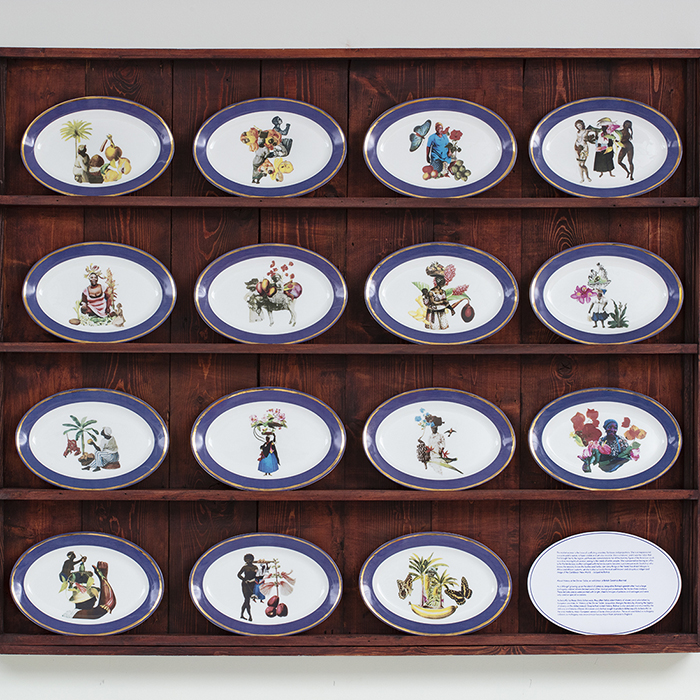The Market Woman Story
edition of 3
2023
digital print on commercial porcelain
various dimensions
Now part of the permanent collection at the Williams College Museum of Art
THE MARKET WOMAN STORY
Limited edition set | Edition of 3
RECENTLY ON VIEW
ABOUT The Market Woman Story
More on Jacqueline Bishop HERE
As a little girl growing up on the island of Jamaica, Jacqueline Bishop’s grandmother had a large mahogany cabinet where she kept some of her most prized possessions: her bone china crockery. These delicate pieces were painted with bright, cheerful images of palaces and carriages and were only used on special occasions.
As beautiful as these china dishes were, they often hid a violent history of slavery and colonialism by European countries. In ‘History at the Dinner Table’, Jacqueline changes the story by showing the legacy of slavery on the dishes instead. Despite their violent history, Bishop is also seduced and charmed by the delicacy and beauty of bone chinaware and she has sought to produce dishes equally as beautiful as the ones made by major European centers of bone china production. The work is exhibited in mahogany cabinets as mahogany was once a major luxury import from Jamaica to England.
STATEMENT
ON “THE MARKET WOMAN STORY”
On one hand, the market woman/huckster is the most ubiquitous figure to emerge from plantation Jamaica. Yet, as pervasive as the figure of the market woman is in Jamaican and Caribbean art and visual culture, she remains critically overlooked.
In this set of fifteen dishes, I am both paying homage to the market woman – centering her importance to Caribbean society from the period of slavery onwards – placing her within a critical context. In particular, I place the market woman within a long tradition of female labor depicted in diverse imagery that I have sourced online, including early Jamaican postcards, paintings of enslaved women from Brazil, the colonial paintings of the Italian Agostino Brunias, and present-day photographs, which I collage alongside floral and abolitionist imagery.
I work in ceramics because all the women around me as I grew up – my mother, my grandmother, my great-grandmother – cherished ceramic dinner plates. These were centerpieces kept in one of their most important acquisitions, a specially made mahogany cabinet. To fabricate the plates, it is important that I am working with Emma Price, a British ceramicist based in Stoke-on-Trent in the former Spode factories. In the realization of the series, that connection imbues them with a meaning that shows the long and enduring relationship between England and Jamaica.
My hope in doing this work is to give much respect to the market women of the Jamaican and larger Atlantic world who have fed, and continue to feed, nations. The market woman is the defining symbol of Jamaica and Caribbean societies.
Jacqueline Bishop
NEWS
JACQUELINE BISHOP: The Market Woman’s Story Catalog with Video
August 23, 2022 | Published by British Art Studies
Jacqueline Bishop explains her process and approach to her series of 15 plates depicting collages of Jamaican market women throughout history.
View The Market Women’s Story on British Art Studies.









You must be logged in to post a comment.